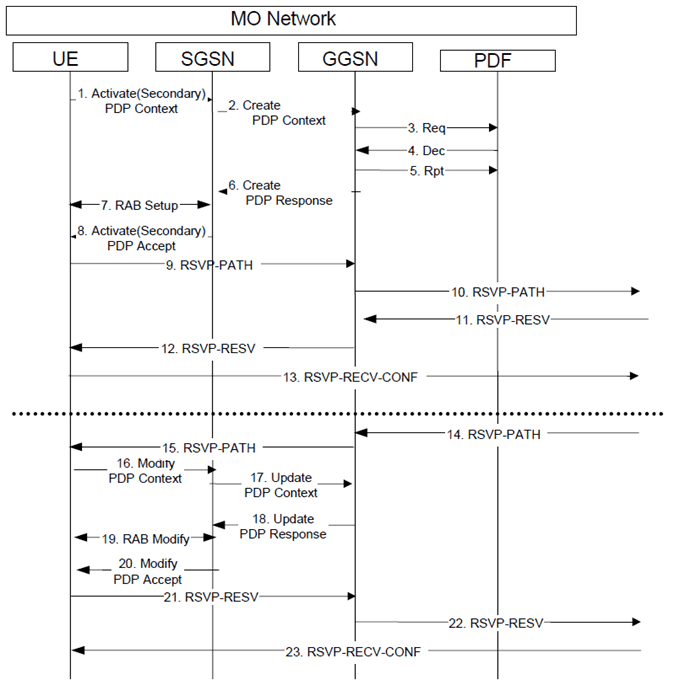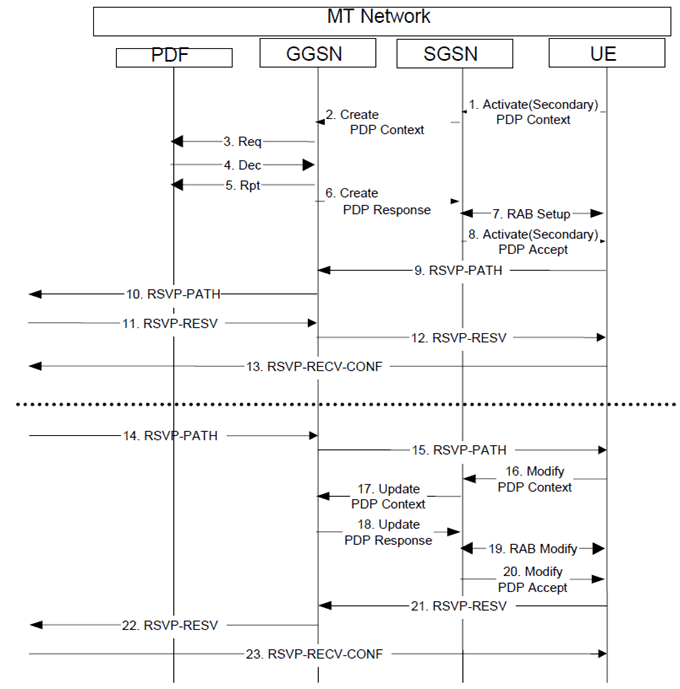Content for TS 23.207 Word version: 18.0.0
D.2 Resource Reservation with End-to-End RSVP and Service-based Local Policy p. 35
For this case, Service-based Local Policy and RSVP are added to the GPRS bearer establishment procedures specified in TS 23.060.
- to trigger the Create PDP Context Request message after the PATH message.
- to trigger the Create PDP Context Request message after the RESV message.
- to trigger only one PDP context after all RSVP exchanges have completed.

Figure D.3: MO Resource Reservation with End-to-End RSVP and Service-based Local Policy
(⇒ copy of original 3GPP image)
(⇒ copy of original 3GPP image)
Step 1.
The following figure is applicable to the Mobile Terminating (MT) side. As the flow is the mirror of the Mobile Originating (MO) side, the step-by-step description is omitted.
The UE sends an Activate (Secondary) PDP Context message to the SGSN with the UMTS QoS parameters. The UE includes the Binding Information in the Activate PDP Context message.
Step 2.
The SGSN sends the corresponding Create PDP Context message to the GGSN.
Step 3.
The GGSN sends a COPS REQ message with the Binding Information to the PDF in order to obtain relevant policy information.
Step 4.
The PDF sends a COPS DEC message back to the GGSN.
Step 5.
The GGSN sends a COPS RPT message back to the PDF.
Step 6.
The GGSN maps IP flow based policy information into PDP context based policy information and uses the PDP context based policy information to accept the PDP activation request, and sends a Create PDP Context Response message back to SGSN. The GGSN may cache the policy information.
Step 7.
RAB setup is done by the RAB Assignment procedure.
Step 8.
The SGSN sends an Activate (Secondary) PDP Context Accept message to UE.
Step 9.
UE sends a RSVP PATH message to GGSN. The UE includes the Binding Information.
Step 10.
The GGSN uses the policy information to accept the RSVP PATH message, and forwards the RSVP PATH message to the next hop.
Step 11.
The GGSN receives the RSVP RESV message in the downlink direction.
Step 12.
The GGSN uses the policy information to accept the RSVP RESV message, and forwards the RSVP RESV message to the UE.
Step 13.
The UE sends a RSVP RESV-CONF message to the next hop. The use of the RESV-CONF message is optional.
Step 14.
The GGSN receives a RSVP PATH message in the downlink direction.
Step 15.
The GGSN forwards the RSVP PATH message to the UE.
Step 16.
The UE may send a Modify PDP Context message to the SGSN with the necessary modification to UMTS QoS parameters according to the received RSVP PATH message. The UE includes the Binding Information in the Modify PDP Context message.
Step 17.
The SGSN sends the corresponding Update PDP Context message to the GGSN.
Step 18.
The GGSN uses the policy information to accept the PDP modification request, and sends a Update PDP Context Response message back to SGSN.
Step 19.
The radio access bearer modification may be performed by the RAB Assignment procedure.
Step 20.
The SGSN sends a Modify PDP Context Accept message to UE.
Step 21.
The UE sends a RSVP RESV message to the GGSN. The UE includes the Binding Information in the RSVP RESV message.
Step 22.
The GGSN uses the policy information to accept the RSVP RESV message, and forwards the RSVP RESV message to the next hop.
Step 23.
The UE receives the RSVP RESV-CONF message in the downlink direction. The use of the RESV-CONF message is optional.

Figure D.4: MT Resource Reservation with End-to-End RSVP and Service-based Local Policy
(⇒ copy of original 3GPP image)
(⇒ copy of original 3GPP image)